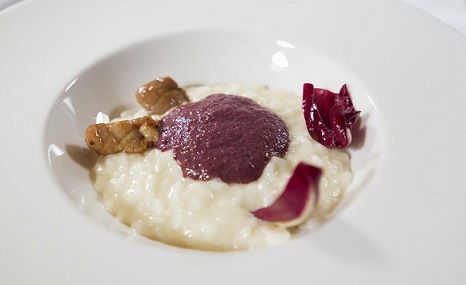Storico Ribelle risotto with Treviso radicchio foam and vanilla-glazed sweetbreads

This recipe for a ‘Historic Rebel’ cheese risotto is from Chef Simone Zanoni of the Le George restaurant in Paris’ Four Seasons Hotel Le George V (1 Michelin star).
Ingredients for 4 people:
For the risotto: 320g Acquarello Carnaroli rice, 1.5l chicken broth, 50g Shea butter, 50g 2015 Storico Ribelle* cheese, 70g 2011 Storico Ribelle cheese, black pepper and white wine.
For the sweetbreads: 200g veal throat sweetbreads, Madagascar vanilla, veal jus and chicken broth.
For the Treviso radicchio foam: 250g late-harvest Treviso radicchio, 70g Amarone della Valpolicella Zenato and 20g butter.
Directions:
Let the vanilla sticks infuse in the veal jus for a day.
Wash the sweetbreads in water and then dry and parboil them for three minutes and let cool. Clean all the grease off the sweetbreads and remove the nerves. Cut the sweetbreads into 1cm square cubes.
For the foam: clean the Treviso radicchio, keeping aside the hearts as garnish, then wash and dry wash. Cut the radicchio with a knife then stir fry it in a hot pan dousing it with the wine and seasoning it with salt and pepper before adding a knob of butter. Blend everything in a mixer and put it in a siphon with a double-gas charge.
Toast the rice and then cook it almost dry adding small amounts of chicken broth at a time then mix in the two ‘historic’ cheeses, which have previously been grated, and the Shea butter.
Brown the sweetbreads in a pan and glaze them using the vanilla-infused jus and place five cubes on each risotto together with a knob of the foam and the radicchio tips that have been seasoned with oil, salt and balsamic butter.
*The Storico Ribelle (Historic Rebel) cheese is a Slow Food Presidium and is typical of North Lombardy. The historic nucleus of the production is in Gerola and Albaredo valleys, where Bitto river runs, in the area of Sondrio. The cheesemakers who work in the mountain dairies, located at altitudes between 1,400 and 2,000 meters, have preserved traditional practices that exalt the quality of the cheese and play a fundamental role in preserving the Alpine environment and biodiversity. The pasture is “turned,” as the herd of cows is led in stages from the lowest station to the highest. The milk is often processed directly in the meadows, in “calécc”, ancient stone constructions that dot the mountain slopes. Orobica goats are also taken up for summer pasturing and Historic Rebel cheese is made with 10 to 20% goat’s milk, which confers aromaticity and persistence.
Aged Historic Rebel cheese is a truly extraordinary cheese, and after six or seven years of aging, sometimes even more, it becomes a rare delight, to be savored on its own.
Wine to pair:
Ripassa Valpolicella Ripasso Doc Superiore Zenato
This wine is closely connected to the greatest wine of Valpolicella: Amarone. After pressing the dried grapes from which Amarone is made, Valpolicella wine is passed over the still warm marc of Amarone. A second alcoholic fermentation begins which increases the alcoholic content and the wine becomes richer in color, bouquet and body. Deep ruby red. Intense, elegant and persistent bouquet with hints of black cherry and plum. Harmonious and velvety on the palate, with good structure.
Production area: Sant’Ambrogio di Valpolicella, on the hills of the Classic area. South-East and South-West exposure. Average altitude of the land: 250-300 m a.s.l. Type of soil: mostly limy clay.
Grape varieties: 85% Corvina, 10% Rondinella, 5% Oseleta. Guyot training system with around 5,000 vines per hectare. Average age of the vineyard: 10/15 years
Winemaking: manual harvest in the first and second 10-day periods of October. The grapes are de-stemmed and macerated in stainless steel fermenters for 10-12 days. Once the alcoholic fermentation is completed, the new wine is separated from the skins by light pressing and conserved in stainless steel barrels until January. At this point, the Valpolicella is passed over the marc of the Amarone for a period of 7-8 days at a temperature of 25-28°C. The wine is aged for 18 months in oak barrels and finally for a few months in bottles, stored at a controlled temperature.
Serving temperature: at 18°C.
Suggested food pairing: excellent companion to game dishes, grilled meat and roasts, salami and aged cheeses.

 Italiano
Italiano






